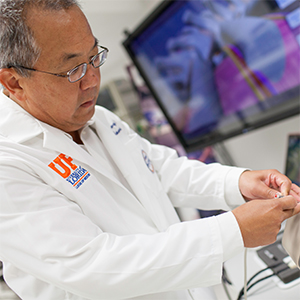
University of Florida and U.S. Army Research Laboratory Simulation and Training Technology Center researchers have received a $1.75 million grant to help military medical personnel acquire, practice or maintain key skills to quickly and efficiently treat and stabilize wounded soldiers with life-threatening injuries. The grant is funded by the Telemedicine & Advanced Technology Research Center, a subcommand of the U.S. Army Medical Research and Materiel Command.
Led by Samsun Lampotang, Ph.D., director of the UF Center For Safety, Simulation & Advanced Learning Technologies, the team will design, develop and validate portable, durable simulators to help train military clinicians for five different medical procedures. The proposed simulators are based on innovative technologies developed at UF, which UF Health researchers are tailoring and improving to meet the military’s needs.
Additionally, the team will assess whether these simulators are effective as training tools, change patient care practices, improve patient outcomes and are cost-effective.
“This translational simulation in health care component of the grant is aligned with the recent addition of simulation as a new core activity of the NIH-funded UF Clinical and Translational Science Institute,” Lampotang said.
With support from the UF CTSI, the UF Center for Safety, Simulation & Advanced Learning Technologies is helping to align, advance and expand access to novel simulation resources available at UF. The center offers education and training, research and technology, and services and support to facilitate use of simulation in translational research and health care.
Read more about the recent grant:
UF developing mixed-reality simulators for training in treatment of injured soldiers

